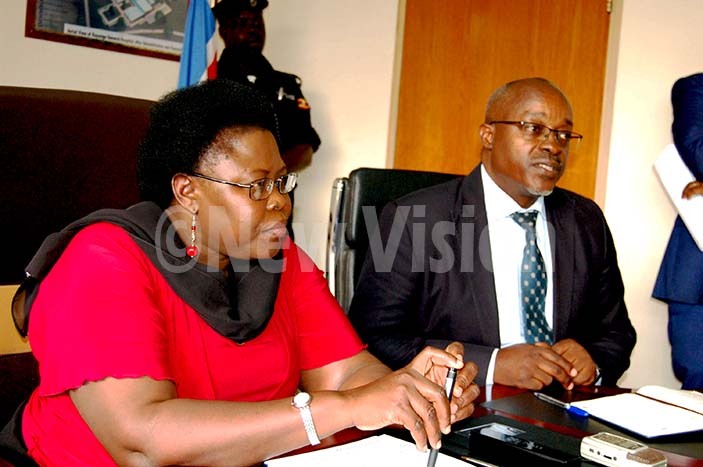Gov't to regulate ambulance services under new policy
Dr. John Baptist Waniaye, the commissioner for emergency care services hopes that the policy if approved will lower the cost of ambulance services in the country.
HEALTH EMERGENCY
KAMPALA - The Emergency Medical Services (EMS) policy, which is before the cabinet for review, seeks to define the standards and norms of ambulances in Uganda.
Dr. Joyce Kaducu, the minister of state for primary health care notes that the policy comes at a time when any form of car is given a siren and turned into an ambulance while genuine ambulances are turned into transport vehicles for food staffs and building materials.
 Dr. Joyce Moriku Kaducu(left) state minister for primary health care and Dr. Alexander Bangirana from accident and emergency department at Mulago hospital, addressing journalists about the emergency medical care and response in Uganda. This was at the ministry of health headquarters in Kampala on Tuesday5, 11, 2019.Photo by Sylvia Katushabe.
Dr. Joyce Moriku Kaducu(left) state minister for primary health care and Dr. Alexander Bangirana from accident and emergency department at Mulago hospital, addressing journalists about the emergency medical care and response in Uganda. This was at the ministry of health headquarters in Kampala on Tuesday5, 11, 2019.Photo by Sylvia Katushabe.
Speaking at a press briefing at the Ministry of Health headquarters this morning, she said the policy will define what an ambulance is and the kind of equipment it should have.
Dr. John Baptist Waniaye, the commissioner for emergency care services hopes that the policy if approved will lower the cost of ambulance services in the country.
According to Dr. Waniaye, the cost of ambulance services in Kampala is very high and exorbitant. Ambulance transport in Kampala costs around sh150,000 while in areas like West Nile, the cost can go up to sh3m.
He noted that through the policy they will establish a district system whereby every health Centre IV has a type B ambulance. Type B ambulance has basic life support equipment.
Currently, there are 421 ambulances in the country, out of which 181 (Type B) are in government, 124 in private not for profit organizations and 116 in private facilities.
Tom Kyobe, President Association of Ambulance Professionals of Uganda, said that a standard ambulance costs about $22,000 (sh81.4m) while the more specialized ones cost up to sh500m each. In Uganda, he added, commonly used are the Type B ambulances.
The briefing was organised to unveil the mass casualty drill that will take place at Kololo Independence grounds on Thursday this week.
The drill is aimed at assessing the response of institutions to a mass casualty situation, both at the site of the event and the site where medical care is administered using existing inter-institutional emergency and disaster plans and protocol.
Kaducu noted that the outcomes of the exercise will be used as a benchmark of standards and best practices that can be adopted and implemented through the EMS policy.
"This move is to ensure that we are systematic in establishing quality and sustainable structures as we work towards rolling out the national EMS," she said.
The policy also stipulates for the training of emergency care professionals including ambulance drivers, establishing a regionally coordinated EMS system, establishing and making of emergency units functional at health facilities, and public health education on health emergencies.
Kaducu said the policy will address the numerous challenges around emergency medical services and reduce mortality rates.
"Emergencies, whether due to road traffic crashes, violence, maternal health complications, illness or other causes, affect not only the immediate victim but also his or her family and members of the surrounding community," she said.
She called on Ugandans to acquire skills in administering first aid during emergencies, noting that so many lives can be saved through first aid.
Kyobe noted that alongside the policy, they are drafting the national curriculum on first aid so as to standardize the training in the country.
He said they are also going to train ambulance drivers on first aid, noting that they need to know basics such as stopping the bleeding before rushing victims to health centres.
Emergencies rank among the top 10 causes of deaths in Uganda. The Ministry of Health annual sector performance report 2017/18 noted that emergencies contributed 7.3% of the major causes of mortality in Uganda. In Kampala alone, over 2,500 deaths were registered in the 2018/19 financial year.
According to Dr. Alexander Bangirana, the head accident and emergency unit, Mulago hospital, every month between 1,600 and 1,800 patients are registered. 40% of these are as a result of traffic crashes.
Kaducu said through the policy, they hope to develop sustainable solutions that will increase access to emergency medical services across the country and halve preventable deaths of Ugandans.